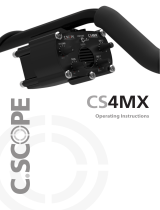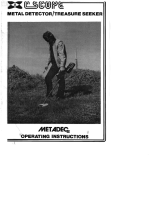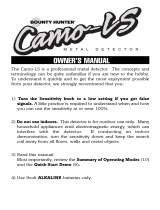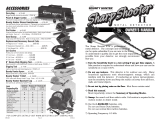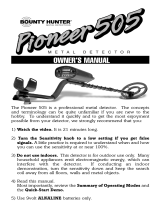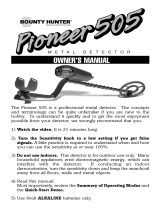Page is loading ...

C.Scope CS770XD AUDIO DISC Metal Detector

1. Control box
2. Main stem
3. Hand grip
4. Armrest/detector stand
5. Lower stem
6. Twistlock stem adjuster
7. Search-head
8. Search-head retaining screw, washers, nut
9. Search-head lead
10. Loudspeaker
11. Headphone socket (rear of control box)
12. Battery compartment
13. Battery compartment cover
14. On/off/sensitivity control
15. Retune push-button
16. Inland/beach site selector.
14
15
11
6
2
1
8
7
9
10
3
5
naming of the parts
The CS770XD is a lightweight professional format metal
detector with target identication facility. The smart
operating system recognises metal targets which are
likely to be worthless. The detector is extremely easy to
use but you will be a better treasure hunter if you take the
time to read this manual carefully and understand what the
controls are doing.
CS770XD - Rapid get you going instructions
Assemble and adjust for length. Twist surplus lead around the stem.
Insert battery so that the terminals line up easily with the contacts in the battery
compartment. (9volt MN1604, PP3 type )
Switch on at the on/o/sensitivity control (14)
Simultaneously press the retune button (15) and keep it depressed whilst turning the
Sensitivity Control (14) to a point where a tone is just about audible or even a little lower
where the tone is just absent. (known as ‘the threshold point). This position should be found
around the start of the green area on the scale. Release the retune button.
Switch the site selector (16) to ‘inland’.
Press the Retune button (15) once. Reset the sensitivity (if necessary) to the point where a
tone is just about audible.
Start searching using a relaxed motion swinging the search-head from side to side as close
to the ground as possible.
C.Scope CS770XD Audio Disc Metal Detector
4
12
13
16

Press the Retune button (15) every few minutes or whenever the background tone rises
to an unacceptable level. You are now searching in ‘inland audio discrimination mode’.
The presence of a metal target will be indicated by the increasing intensity of the tone.
Signals from targets likely to be valuable will give a high pitch tone. Signals from targets
likely to be worthless will give a low pitch tone.
For beach hunting switch the site selector (16) to ‘beach’ and press the retune button.
Reset the threshold point if necessary. You are now searching in ‘beach preset
discrimination mode’. Signals from targets likely to be valuable will give a tone increasing
in intensity. Signals from targets likely to be worthless will be ignored.
THE CONTROLS AND WHAT THEY DO
(14) The on/o/sensitivity control switches the machine ‘on’ and sets the sensitivity level.
The detector sensitivity should normally be set at the point of threshold, that is the point at
which a background tone is just about audible. The point of threshold will be found within
the green area on the scale. Set the threshold point with the detector head held just above
the surface of the ground. Switch the machine ‘on’ and with the other hand press the retune
button (15). Keep the retune button depressed while you rotate the sensitivity control to a
point where the background tone is just audible or just absent. (this is called ‘the threshold
point’ ). Then release the retune button and the detector is ready. In severe ground
conditions (wet salt beach or mining areas for example) it may be necessary to reduce
sensitivity to below the threshold point in order to achieve stable operation.
(16) Inland/beach site selector. The detector can ignore the signals from some metals
which are likely to be worthless. Small iron objects like building nails are the main source
of false signals, especially on farmland sites. The CS770XD recognises these objects and
allocates them a low pitch tone in Inland Mode or ignores them completely in Beach Mode.
Items that are most likely to be valuable give a high pitch tone in Inland Mode or increasing
in intensity (volume) in Beach Mode.
(15) Retune Push-button. The purpose of the Retune push-button is to keep the
detector working at peak performance by maintaining the point of threshold set on the
sensitivity control. For example, moving from dry ground to wet ground may cause the
background tone to gradually increase to an unacceptable level. Pressing the retune button
momentarily will bring the background tone to the point of threshold again.
If the retune button fails to have this eect, it is probably necessary to re-set the sensitivity
level. It is good detecting practice to press the retune button every few minutes or
whenever you feel that that the detector may have drifted away from its sensitivity setting.
Assembly
Join the two stem sections (5)(2) together. Wind the search-head lead (9) around the
stem as shown in the photograph. Adjust the stem for length according to your height
(it’s easier on your back if you can stand up straight while detecting) and tighten the
twistlock stem adjuster (6). Check that the search-head (7) is parallel to the ground when
being swept in an arc and tighten (be careful not to over-tighten) the search-head retaining
screw (8). (Keep these parts clean - if they become covered in mud or sand wash and
dry these parts at the end of a day’s detecting. Don’t allow any form of lubricant onto the
rubber friction washers.)
Battery
Push back the retaining clip and remove the cover (13) of the battery compartment (12).
Fit a 9 volt battery (MN1604, PP3 or equivalent). There are guide strips to ensure the battery
is tted the right way round. Do not force the battery. It should slide in easily to connect with
contact strips in the compartment. Remove the battery if the detector is to be stored for more
than a few days.
Searching Technique: Try out a variety of targets to test the reaction of the audio target
analysis system. Iron nail, gold ring, £1 coin, for example. Check the intensity and the
pitch of the signal. Note how the detector signal changes and, as you gain experience

of this feature, you will become adept at making decisions about whether to dig or not.
For starters, if you are in any doubt, it’s safer to dig! Sweep the detector head from side to
side in a smooth arc. Move forward at each sweep the width of the search-head. Keep the
search-head as close to the ground as possible, even at the ends of the arc where there is
a natural tendency for the search-head to lift. Maintain a strict search pattern so that the
area being searched is completely covered. (You will be more successful if you cover a small
area of ground thoroughly than if you search a large area of ground in random fashion. The
non-motion electronic system is most suited to a careful detecting technique). When you
encounter a signal, move the search-head slowly around the area. The signal is strongest
when the target is directly below the centre of the search-head. Use the tone ID system to
help decide if you are going to dig this signal. Remove the clod of earth where the signal
appeared using a sharp digging tool. Check further by passing the search-head over the
clod to see if the target is there or deeper in the hole. Replace the earth after recovery of the
object and it should be dicult to see that the ground has been disturbed.
Important note: the 2-tone target analysis only functions in inland mode. We designed it
this way because experience has shown that typical rubbish metal objects encountered on
the beach are generally dierent to those found on inland sites.
Do not trespass. Ask permission before searching on private land. Check for local bylaws
about detecting on public land. Not all countries have such a positive attitude towards
treasure hunting as we have in the UK. Observe the Country Code. Fill in all holes. Report
all valuable or historically interesting nds to the appropriate authority. Do not touch any
item suspected of being unexploded munitions - mark its position and report to the police
immediately.
Contact C.Scope or your local detector supplier for a range of C.Scope Accessories:
Headphones: make it easier to hear weak signals and increase battery life. The headphone
socket is underneath the control box (11).
Search-head cover: protect the underside of the search-head from abrasion damage.
Extends the life of the search-head.
Rechargeable batteries. Digging Tools. Detector Bags.
Detector Care
The CS770XD is a robust design. However, the control box should be treated with similar
care as any electronic product. Dry o any water splashes immediately. The search-head
may be immersed in water. Stem and search-head parts should be washed with tap water
and dried at the end of a day’s detecting. Do not use solvents.
Warranty & Service
The CS770XD is guaranteed free of manufacturing defects as conrmed in our written
warranty document. Contact us if you have any concerns about the operation of your
detector. The C.Scope Customer Service Team really know about metal detectors and are
always ready with good advice and rapid after-sales-service.
Waste electrical products should not be disposed of with household waste.
Please recycle where facilities exist. Check with your local authority or retailer
for recycling advice.
(In the UK visit www.recycle-more.co.uk)
C.SCOPE INTERNATIONAL LTD
KINGSNORTH TECHNOLOGY PARK WOTTON ROAD ASHFORD KENT TN23 6LN UK
Telephone: +44(0)1233 629181 Fax: +44(0)1233 645897
email: info@cscope.co.uk web: www.cscope.co.uk
C.SCOPE is an ISO 9001 Quality Manufacturer.
This equipment conforms to the EMC directive 89/336/EEC.
System performance may be impaired by unusually strong electromagnetic fields.
B1073 ISSUE 2
/







